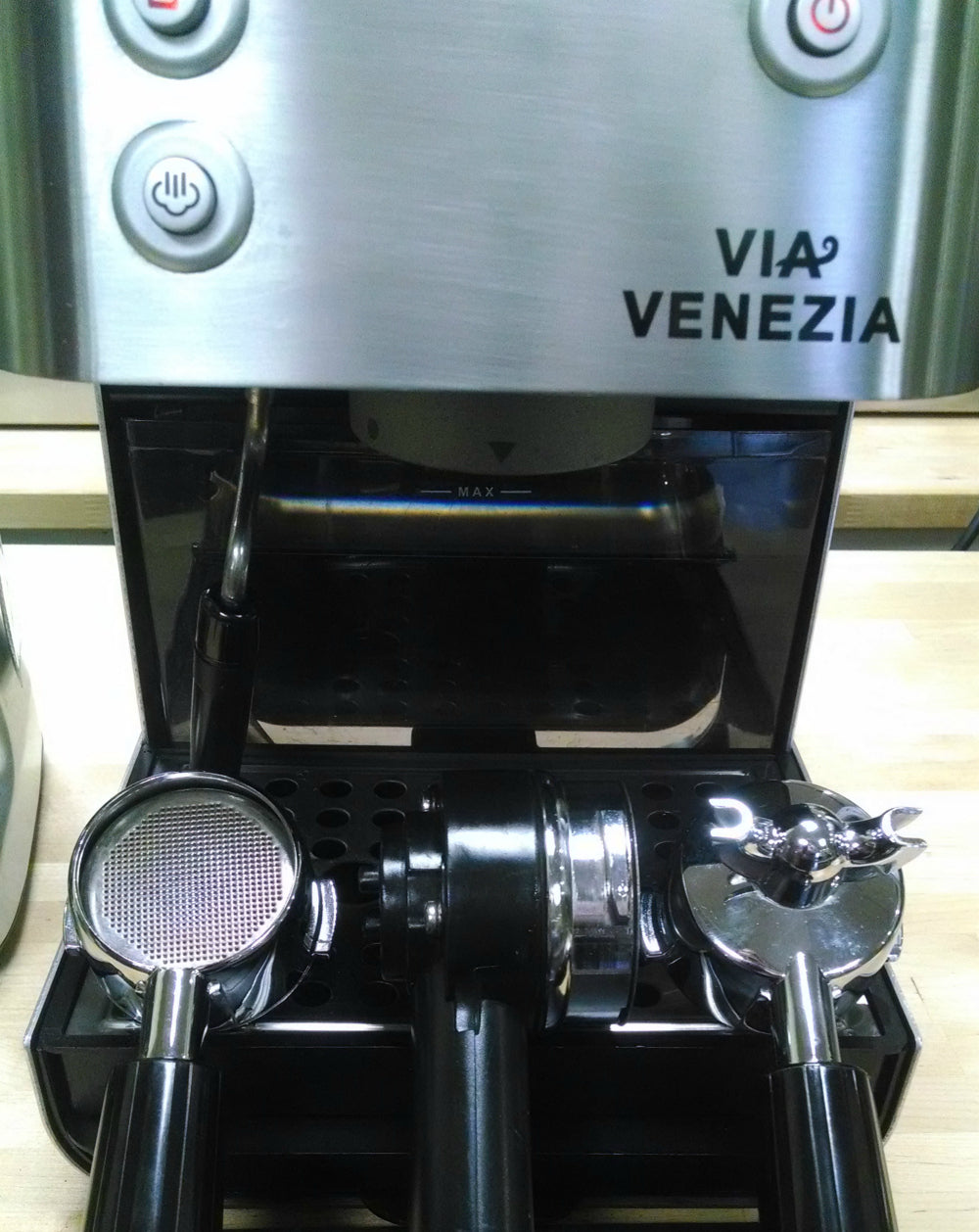From bean to cup, making espresso at home is poetry in motion. Nothing captures the essence of espresso better than a close up view of a streaming bottomless portafilter -- a portafilter designed without spouts so that the bottom of the filter basket is visible. Bottomless, pressurized, non-pressurized … though they do the same job, they each do it a little differently. To get the most out of any espresso machine, let’s get to know the portafilter a little better.
First off, what exactly is a portafilter? Some people call just the handle portion portafilter and some people call the handle and filter basket combination portafilter. Some people also call it a portaholder, and that is a little weird, but we understand what you mean. Once the filter basket is filled with ground coffee, the portafilter can be locked into place inside the brew head of your traditional espresso machine. Locked and loaded! Now you are ready to pull espresso shots … If it were only that easy! To illustrate the differences between types of portafilters, I chose the Saeco Via Venezia. It is a semi-automatic home espresso machine that comes with a pressurized portafilter. There is also a non-pressurized portafilter and bottomless portafilter upgrade available for it, so it makes a good example of how each portafilter works to create a different espresso experience. All three portafilters use the original included double filter basket. Here’s how they compare: Pressurized - The espresso flow is greatly restricted. When the pressure from the boiler combines with an added restriction, it literally spits the coffee out. The restrictive design can be part of the filter basket, part of the portafilter (the Via Venezia uses an additional gasket) or a spring between these two pieces. Pressurized portafilters often come standard on entry-level espresso machines because they are easier to use for beginners. The coffee doesn’t have to be perfectly fresh, the size of the grind can have a little bit more variation and tamping is not necessary in most cases. In exchange for this ease of use, the cleanup is messier because the leftover puck is wetter. It is hard to explain the taste difference but a pressurized shot will taste a little bland and homogenous when compared with a non-pressurized espresso shot. The crema produced is mainly a function of extra pressure and not an indicator of coffee freshness. It adds to the visual appeal but not the taste. However, if you are making milk-based drinks you will probably not notice these small differences. Non-Pressurized - The 15 bar pressure from an espresso machine forces the water and steam through the filter basket. A good espresso extraction needs freshly ground coffee with a consistent particle size. It is also important to tamp evenly with the right amount of pressure so that water flows through in a uniform manner. If espresso flows out one side more than the other, it will still taste okay, but it might have had the potential to taste better with a more even tamp, or a more accurate dosage, or more consistently ground coffee. This is the point where you can seriously start to geek out about your espresso-making methodology! Non-Pressurized portafilters are for home baristas ready for the challenge to manage variables manually. If you have an interest in crafting delicious espresso, you need a non-pressurized portafilter. This is especially true if you drink espresso, Americano coffee or a Cafe Macchiato. These are drinks where the character of the espresso is front and center compared to a latte or cappuccino where the espresso takes a backseat to ten ounces of milky goodness. Bottomless - (Sometimes called a naked portafilter.) Usually, the spouts on the bottom of the portafilter direct the coffee as it streams out. Not so with a bottomless portafilter. As a learning tool for a home barista, the bottomless portafilter is a great way to check your progress. The term ‘channeling’ refers to water that leaks through the puck unevenly due to poor distribution of grounds. Other reasons these crevasses occur can be due to an inconsistent grind, incorrect dosage or an uneven tamp. Any small error will result in random spurts and a messy espresso extraction with a bottomless portafilter. The barista can then take steps to fix one or more of these variables in the hopes of producing a cleaner (and better tasting!) shot. Some say a bottomless portafilter will make a hotter shot since the espresso does not come into contact with a metal spout. This temperature difference is pretty negligible. It is easier to brew directly into a demitasse and it is easier to keep clean. But the main reason to use a bottomless portafilter is the visual cues it offers that can lead you to micro adjustments in timing, tamping and measurement. About Filter Baskets - An E61 filter basket is 58mm across while the Via Venezia filter basket is 53mm across and DeLonghi tends to run about 51mm across. Sizes, shapes and hole patterns vary by manufacturer. There is no consensus on whether bigger is better or which proprietary hole pattern is better. The often frustrating thing for home baristas to keep in mind is that most portafilters and filter baskets are not interchangeable between brands. Even if they share the same size diameter, their profile shape will prevent a universal fit in the portafilter or brew head configuration of a different model espresso machine. When looking for a replacement or upgrade, double check compatibility first! Along with the functional differences listed above, some portafilters are heavier, some are lighter weight and some may feel more balanced in your hand. The tactile sensation of the portafilter is important too. Will the portafilter be ergonomic for all household users? These are seemingly small details to consider when evaluating an espresso machine purchase but it will be part of your daily routine for years to come, so it's best to shake hands and get to know your portafilter first!